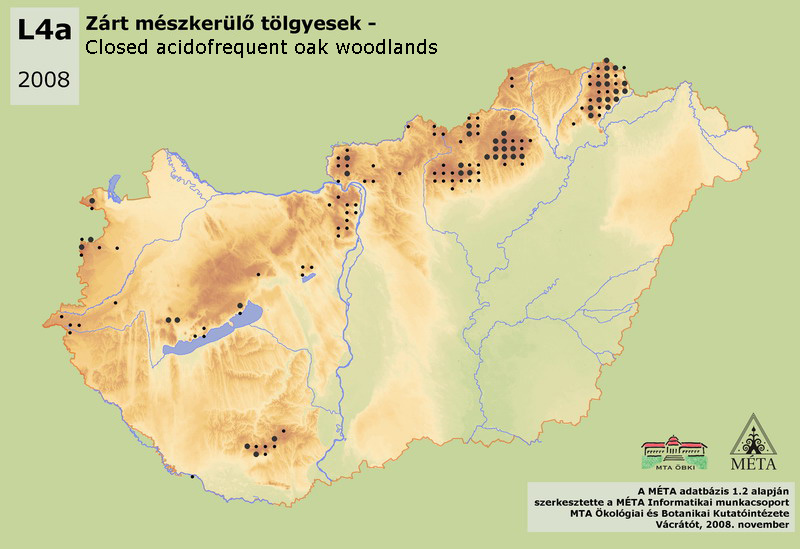MÉTA Program >>> Habitat distribution maps


L4a – Closed acidofrequent oak woodlands:
Low or medium high growing, closed forests in the oak and beech zone, developed on extremely acid soils. Submontane habitat type, connected to acid bedrock (andesite, rhyolite, granite, acid sandstones, shales) and to shallow, dry soils, occurring mainly on south slopes. The dominant tree species is Quercus petraea, the shrub layer is missing, the herb layer is characterised by acidofrequent forest species [Luzula luzuloides, Deschampsia (Avenella) flexuosa, Vaccinium myrtillus, etc.], the moss layer can be significant. The total area of the habitat is 2300 ha in Hungary. The greater part of the occurrences is in the higher regions of the Északi-középhegyég (Sátor-hegység, Bükk, Mátra, Heves-Borsodi-dombság, Börzsöny). There are some sporadic occurrences in the Dunántúli-középhegység (300 ha, especially in the Visegrádi-hegység, Budai-hegység, Velencei-hegység, and on Balaton-felvidék). It can be found at the western edge of Nyugat-Dunántúl (100 ha, Soproni-hegység, Kőszegi-hegység, Őrség-Vendvidék) and on Dél-Dunántúl, in Mecsek (200 ha). Though it is usually easy to recognize this habitat, there are barely identifiable transitional stands towards turkey oak woodlands (L2a, L2b).
Molnár, Zs., M. Biró, J. Bölöni & F. Horváth (2008): Distribution of the (semi-)natural habitats in Hungary I.: Marshes and grasslands, Acta Botanica Hungarica 50 (Suppl): 59-105. >>> letöltés (5,4 MB, PDF)
MÉTA Program,
MÉTA Fotótár
MÉTA Élőhely-Ismereti Útmutató (ÉIÚ),
MÉTA Adatlap-Kitöltési Útmutató (AL-KÚ)
(C) MÉTA Informatika, 2005-2009,
MTA Ökológiai és Botanikai Kutatóintézete